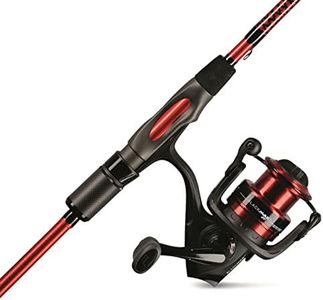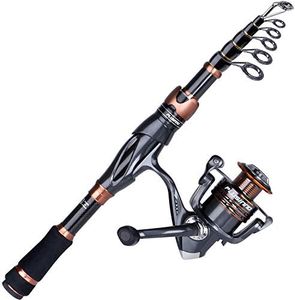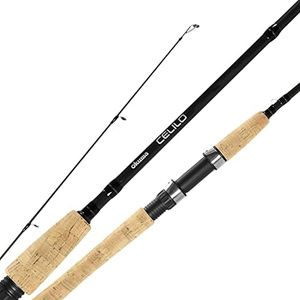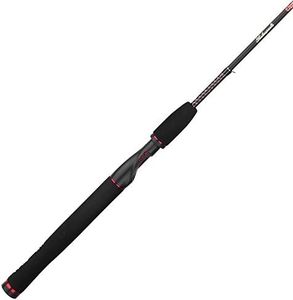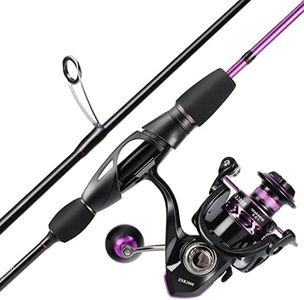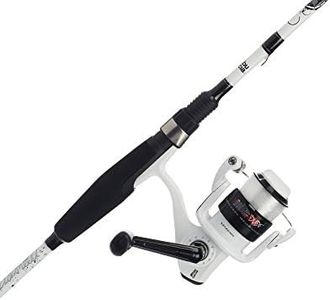We Use CookiesWe use cookies to enhance the security, performance,
functionality and for analytical and promotional activities. By continuing to browse this site you
are agreeing to our privacy policy
10 Best Crappie Fishing Rods
From leading brands and best sellers available on the web.By clicking on a link to a third party's website, log data is shared with that third party.
Buying Guide for the Best Crappie Fishing Rods
Choosing the right crappie fishing rod can make your fishing experience much more enjoyable and successful. Whether you're a beginner or a seasoned angler, it’s important to understand what type of rod matches the way you like to fish, the environments you frequent (like lakes, rivers, or ponds), and the typical size of crappie in your area. By understanding the key features of crappie rods, you can ensure you pick one that's comfortable to use and increases your chances of catching fish.Rod LengthRod length refers to how long the fishing rod is from the handle to the tip. This is important because longer rods generally allow for longer casts and better reach, which is helpful when trying to keep distance from the fish or fishing in areas with lots of cover. Crappie rods typically range from 5 to 16 feet. Short rods (5-7 feet) are great for fishing from boats or in tight spots, offering more control. Medium rods (8-11 feet) provide a good balance of casting distance and control, making them versatile. Longer rods (12-16 feet) are best for techniques like 'spider rigging' or reaching across brush piles. To pick the right length, consider how and where you’ll fish most—if you fish from the bank or need to reach over obstacles, a longer rod may serve you better. If you fish in tight spaces or from a kayak, a shorter rod is more practical.
Rod ActionRod action describes how much and where the rod bends under pressure. Fast action rods bend mostly at the tip and are sensitive, allowing you to feel even light bites, but they are stiffer which helps with hook sets. Moderate action rods bend more towards the middle and offer a compromise between sensitivity and flexibility, giving you a bit more forgiveness if a fish runs. Slow action rods bend throughout most of their length, making them better for absorbing sudden movements, but they can reduce sensitivity. For crappie, where bites are often light, most anglers prefer light or moderate action rods since they help detect subtle nibbles without tearing the hook from the fish’s soft mouth.
Rod PowerRod power is how much weight it takes to bend the rod, usually described as ultralight, light, medium, or heavy. For crappie fishing, ultralight or light power rods are ideal since crappie are not very big or strong fish. An ultralight rod makes it fun to catch even small crappie, while still providing enough backbone to land larger ones. If you plan to fish in areas with a lot of snags or might catch larger fish occasionally, a light power rod adds a bit more strength without losing much sensitivity.
Rod MaterialRods are commonly made from fiberglass, graphite, or a combination of the two (composite). Fiberglass rods are more flexible and durable, making them better suited for beginners or rougher conditions. However, they are a bit heavier and less sensitive. Graphite rods are lighter and more sensitive, making it easier to detect bites, but can be more brittle and expensive. Composite rods offer a balance between the two. Consider graphite or a composite rod if sensitivity and weight matter, especially if you’re holding the rod all day. For kids or high-durability needs, fiberglass might be a better pick.
Handle Type and LengthThe handle is where you grip the rod, and it’s usually made from cork or EVA foam. Cork is comfortable and provides a good grip even when wet, while EVA foam is softer and more durable. Handle length also matters—shorter handles are easier for single-handed casting and give more precision, which is helpful if you’re jigging. Longer handles let you use both hands when casting further or fighting bigger fish. Think about what feels comfortable to hold for long periods and matches your fishing style.
Number of PiecesSome rods are made in one solid piece, while others break down into two or more sections for easier transport. One-piece rods generally feel a bit sturdier and offer smoother performance, but they’re harder to transport. Multi-piece rods can be packed into smaller spaces, which is great for traveling or backpacking, though there may be a slight compromise in sensitivity. If you need portability, multi-piece makes sense; if you prioritize strength and smoothness, a one-piece rod could be preferable.
